MARKETING
Business Leaders Weigh In on the Future of Events
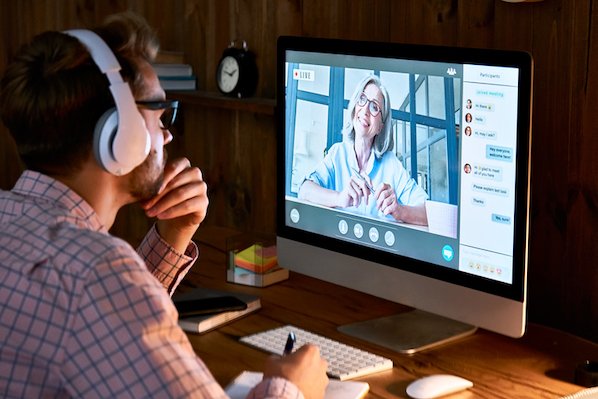
In 2019, Microsoft hosted their annual Ignite event in Orlando for one week. It was the most successful Ignite they’d ever had, with well over 27,000 attendees.
That is, until the fall of 2021 — when they hosted over 270,000 attendees in a virtual version of the same event.
A couple of years ago, the majority of businesses hosted in-person trade shows and conferences. Virtual conferences were a rarity.
But, post-pandemic, we’re seeing a major shift towards virtual or hybrid events. In fact, HubSpot Blog Research found roughly 40% of marketers plan to increase their investments in virtual events, webinars, and conferences in 2022, followed by 39% who plan to spend the same amount as they did in 2021. A mere 16% plan on decreasing their investment.
Bob Bejan, Microsoft’s Vice President of Global Events, is unsurprised by this shift towards virtual, and believes it was always destined to be the future of events.
He told me, “The pandemic is really just an accelerator of something that was going to be inevitable anyway, but probably would have taken five or six years instead of just two.”
Here, I spoke with experts across industries to learn more about the surprising future of events — and whether in-person, virtual, or hybrid will become the norm. Plus, what it could mean for your business.
Let’s dive in.
The Future of Events, According to Experts
The Case for Virtual
We all remember the challenges of in-person events: Shuffling from conference room to conference room, running to catch the last bus back to your hotel, feeling overstimulated by exhibition spaces full of businesses competing for your attention.
Simply put, in-person events can be incredibly stressful and frustrating experiences for attendees — particularly with larger gatherings.
As Microsoft’s Bejan puts it, “The dirty little secret of in-person events is you’re all competing for the biggest number — but the bigger the number, the worse the experience for the attendees.”
Bejan adds, “The power and effectiveness of virtual events is just so convincing from a data perspective that it’s hard to imagine they’re ever going away. Virtual events at every dimension are so much more effective than in-person events.”
Nowadays, you’ll be hard-pressed to find a business leader who doesn’t recognize the benefits of virtual events.
Among other things, virtual events can:
- Lower the price of admission, which can increase attendee count and enable businesses with smaller budgets to take part in your conference and offer unique insights.
- Lower the costs your business would typically pay for conference space, on-hand staff, catering, security, and more.
- Enable people across the globe to interact without needing to spend money on flights and hotels.
- Attract high-demand speakers who might not have the time to attend your event in-person, but are happy to share insights via video call or pre-recorded presentation.
- Provide you with the opportunity to create a product (recordings from your conference) that you can repurpose for future lead generation offerings.
And, as we saw in 2020 and 2021 as a result of the pandemic: Sometimes, virtual events are the only option, when unforeseen circumstances makes in-person events impossible.
Virtual events are incredibly powerful opportunities to reach new audiences and increase brand awareness. In fact, 80% of marketers are able to reach wider audiences and increase their ROI by hosting virtual events.

Virtual events have also come a long way since the early days of webinars. Nowadays, brands are upping the game by offering incredibly unique, immersive virtual experiences.
For instance, consider INBOUND 2021, which enabled attendees to network at virtual meetups, interact in real-time with attendees and speakers, and learn from renowned speakers like Oprah and Spike Lee — all from the comfort of their own homes.
For many brands, virtual events will be the only practical option for events well into the future. As Bejan posits, “If you’re a small or medium-sized business and you’re trying to reach people and deliver impressive experiences, our feeling is that there’s no better way to spend your money than in the digital space.”
However, if you’re wary of virtual-only experiences, you’re not alone. Many business leaders are unsure whether it’s a wise idea to take away the in-person component entirely, particularly when so many attendees learn and network best in-person.
Enter: The hybrid event.
Why Hybrid Is a Powerful Alternative
Picture this: You’re sitting on a beanbag chair, an iced coffee at your side, and you’re looking up at a row of huge, circular screens with a variety of sessions happening concurrently.
You put your headphones on and dial into one session, while the person beside you — with whom you connected earlier, at the food station, and traded business cards — sits and listens to a different one.
While it might sound futuristic, it’s not.
Prior to the pandemic, Bejan and his team worked on shifting Microsoft’s event strategy towards one in which the primary offerings were always digital — known as the “digital core”.
“And then,” Bejan told me, “rather than making destinations — which is the way we used to do events — we would distribute that digital core, and simultaneously activate events around that digital core locally and regionally, so that we can deliver those special and unique things that you can only do in-person.”
These spaces, known as ‘hang spaces’, were exactly as described in the example above. People would sit together in a rented conference space, watch Microsoft’s pre-recorded or live digital sessions, and experience the very networking they craved.
If, alternatively, someone wanted to watch from home, they could do that, too.
This is one hybrid example, but there are many in various forms. Consider, for instance, Social Media Marketing World, an annual conference for social media managers.
As of 2022, the conference is now offered in-person at the San Diego Convention Center, or via remote live stream. If you want to attend the three day event in-person, you’ll need to pay upwards of $1,700 (depending on whether you want an extra day and access to live stream, as well). Alternatively, the on-demand conference costs between $597 and $797.
With a hybrid strategy, you’re solving the needs of two different subsets of people — those who actively seek out in-person experiences, and those who’d prefer to learn remotely. Ultimately, a hybrid strategy is a compelling option if you find your audiences’ preferences are split between in-person and remote.
As ON24’s VP of Strategy & Research Cheri Hulse puts it, “Hybrid has presented itself as a good midway point for marketers as they try to navigate global and regional regulations, audience preferences, and contractual obligations with venues.”
Hulse adds, “Hybrid allows marketers to feel their bases are covered for delivering an event — no matter what is thrown at them leading up to the big day.”
Penny Elmslie, Xero’s GM for Brand & Community, told me that hybrid is an option that excites her as we enter a new era for events.
Elmslie says, “The beauty of a hybrid model is it allows our events to scale, while enabling us to connect with those who for physical, financial, or medical reasons may not be able to attend in person.”
Elmslie adds, “In creating the right experience, we also purposefully make the hybrid delivery shorter and sharper to what you’d expect live, ensuring we respect our audience’s time in front of screens.”
Elmslie continues, “We’ve found the current environment has changed people’s expectations, challenging us to ensure we’re providing enough flexibility in our model to cater to all audiences. Fortunately, advancements in event technology and production skills have enabled us to continue to surprise and delight our audiences in new ways — even when they can’t physically be with us.”
Sarika Abraham, Media & PR Manager at Hexnode, is working on putting together her first hybrid event this year, Hexcon 22.
For her, the biggest challenges include the project management skills required to combine an in-person and virtual event into one seamless experience.
Abraham told me, “With twice the benefits comes twice the labor. Hybrid events are complex and require intricate management of both a physical platform and a virtual stream. I believe that managing the increased complexity, cost, and risks associated with integrating different platforms, tools, and technologies is the pivot of successfully conducting a hybrid event.”
If you’re interested in planning a hybrid event in 2022, you’re in luck. Hulse shared her tips for marketers looking to plan their first hybrid event.
She told me, “My one tip for marketers planning hybrid events is to remain flexible and listen to feedback. When ON24 planned a hybrid event last year, we offered lots of options for attendees to select how they wanted to consume the experience: in-person or virtually.”
Hulse adds, “This was critical as we saw attendees change their mind as the date neared and their situations changed. Ultimately, the success of the event was based on audiences consuming content and engaging with the experience — and we left it up to them to decide how they would do that.”

Reachdesk’s Global VP of Marketing Christy Steward also shared some key takeaways for marketers looking to plan hybrid events in 2022.
Steward told me, “The one piece of advice that I’d suggest for any business running their first hybrid event would be to make sure that you pay equal amounts of attention to both in-person and remote attendees. Although both groups will technically be at the same event, they’ll be having very different experiences, so keep this in mind when planning.”
Steward adds, “A smart gifting strategy can help create an equally memorable experience for every attendee. For example, if you’re providing snacks and refreshments for in-person attendees, make sure you send virtual attendees a coffee voucher before the event or even better a box of coffee beans and something to nibble on during the event.”
Additionally, to ensure your in-person and remote attendees feel equally included, consider how you might leverage unique tools.
For instance, Airmeet’s VP of Product, Vikas Reddy, told me, “Plan for opportunities that will make sure your virtual attendees feel heard through polls, bringing them on the stage, etc. Facilitate networking between in-person and virtual attendees through curated sessions like speed networking, breakouts, and 1-1 meetings.”
Reddy adds, “Also, double down on mobile capabilities that will offer your in-person attendees a digital pocket guide, taking care of everything from navigation to networking. Make sure you capture data for both the set of audiences across all the above mentioned touchpoints. This can contribute valuable insights into what matters to each audience segment and thereby lay down the strategy for future hybrid events.”
All of that is well and good … but what about the people who simply crave in-person experiences?
Let’s explore the future of in-person events, next.
For Some Brands, In-Person is Still Most Effective
Over the next couple years (and depending, of course, on health and public safety regulations), we’ll begin to see some businesses return to hosting fully in-person events. And, for certain industries, in-person will always be the most effective.
Brittani Dinsmore, Head of Marketing at Moz, believes the reason 16% of marketers plan on decreasing their investment in virtual events in 2022 comes down to the need for in-person interactions.
Dinsmore says, “I think we’re seeing a shift away from virtual events because there’s a growing demand to return to face-to-face interactions. Zoom fatigue is a real thing. Many individuals are burnt out from conducting professional and personal meetings through a screen.”
Dinsmore adds, “People can’t experience the full scope of some events, like networking or a convention, from their living room. Live events, in particular, have a certain energy that can’t be replicated virtually.”
For instance, while MozCon, Moz’s annual marketing conference, has been held online for the past two years, Dinsmore told me her team is tentatively planning on hosting MozCon 2022 in person again (as long as restrictions subside).
Along with the benefit of face-to-face connection, Dinsmore makes the point that it’s often easier to generate meaningful leads and attract new sponsors in-person compared to virtual.
There’s also real science behind the importance of in-person interactions. Consider, for instance, how 55% of the impact of our communication comes from body language, 38% from tone of voice, and just 7% from the words themselves.
In a virtual world, it can be difficult to pick up on nuances in body language and tone through a computer screen. Which means some meaningful connection will be lost in a world primarily focused on virtual interactions.

“The move back to in-person events will be gradual,” Dinsmore says, “As new COVID variants pop up, companies will continue to hold hybrid events to serve the groups who feel comfortable meeting in-person and those who prefer attending functions from home.”
Dinsmore continues, “But I think companies should consider sponsoring or engaging in smaller networking groups rather than hybrid events to ease back into things. Once the pandemic subsides, I foresee many planning a grand return to in-person events.”
So … What’s right for you?
Ultimately, the choice of in-person, virtual, or hybrid is largely yours. As Hulse points out, “In the future, I expect to see a mix of event types in the B2B space. Between hybrid, physical, and digital events, it will be up to marketing leaders to calibrate the right mix of the three based on audiences needs and preferences, budget, and marketing priorities.”
And if you do lean towards virtual or hybrid events in the future, consider how you might innovate on what’s already been done. There’s unlimited potential in the virtual and hybrid event space — and we’re really just getting started.
As Bejan told me, “We had one big epiphany when we delivered a streaming version of our Las Vegas show, and found that the largest audience of people watching our keynotes watched from their hotel rooms. So that was an insight for us: As long as you make good, interactive television, you’ll find success.”
“And,” Bejan adds, “in my almost 30 years of business … This is the most compelling work I’ve done in my career. It’s really, really fun.”
Source link
MARKETING
Tips and Tricks for Digital PR
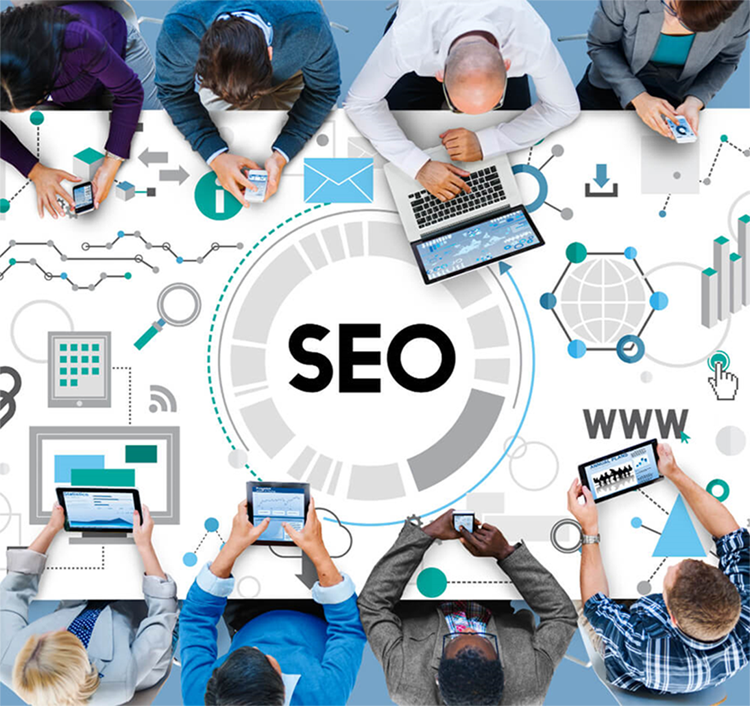
In the bustling digital landscape of the 21st century, public relations (PR) stands as a beacon of brand visibility, trust-building, and reputation management. As businesses navigate the complexities of online competition, the synergy between search engine optimization (SEO) and PR has become increasingly evident. This article delves into digital PR, exploring how strategic integration with SEO practices can elevate brand visibility, drive organic traffic, and amplify PR success.
The SEO & Digital PR Power Couple
In today’s digital landscape, success hinges on a strong online presence. Two crucial aspects of achieving this are SEO and Digital PR. While they may have functioned as separate strategies in the past, they’re now recognized as a powerful team.
SEO focuses on optimizing your website and content to rank higher in search engine results, driving organic traffic. PR, on the other hand, builds brand awareness and cultivates positive press mentions.
However, creating compelling content that resonates with audiences and search engines can be challenging for many PR professionals. A recent Institute for Public Relations study found that nearly three-quarters (70%) of PR practitioners struggle with content creation. This is where the magic of SEO and digital PR working together comes in.
Combining these forces creates a synergy that delivers impressive results. Effective SEO techniques in PR campaigns can amplify brand messaging and ensure it reaches the right audience through search engines.
Conversely, strong PR efforts can generate backlinks to your website, a significant factor influencing SEO ranking. This teamwork propels brands to industry leadership by establishing online authority and positive brand sentiment.
Optimizing Your PR Efforts for SEO
PR and SEO go hand-in-hand in today’s digital marketing landscape. By aligning your PR activities with SEO best practices, you can significantly boost your online presence and reach a wider audience. Here’s how:
Keyword Research
Just like any successful marketing campaign, PR needs a strong foundation. Keyword research is crucial for understanding the language your target audience uses online. According to Google, more than half of consumers (53%) consult online resources before purchasing a product or service.
This includes potential students researching educational options. For instance, terms like “best online degrees for 2024” can be valuable keywords for online schools to target in their PR efforts to reach potential students actively searching for programs.
By identifying relevant keywords with high search volume, PR professionals can craft messaging that resonates with their audience and increases the discoverability of their content in search results.
Content is King (and Queen)
Compelling and newsworthy content is the cornerstone of any successful PR campaign. But for SEO, it’s not just about capturing attention.
High-quality content, such as press releases, blog posts, and infographics, should also be optimized for search engines. This includes using relevant keywords strategically throughout your content and adhering to on-page SEO best practices. By creating content that is both informative and search-engine friendly, you attract not only readers but also valuable backlinks and organic traffic.
Building Backlinks
Backlinks are links from other websites pointing back to yours. Search engines consider backlinks a sign of trustworthiness and authority.
Strategic PR campaigns can help you secure these valuable backlinks by pitching newsworthy content to relevant websites, building relationships with journalists and influencers, and leveraging social media to promote your content. However, focusing on earning backlinks from reputable sources is crucial, as spammy tactics can hurt your SEO efforts.
Optimizing Media Coverage
Every media placement you secure, whether an article, interview, or social media mention, presents an opportunity to enhance your SEO. Encourage journalists and influencers to include relevant keywords and links to your website in their coverage.
Promoting these media placements on your social media channels can amplify their reach and drive more organic traffic to your website.
Advanced SEO Techniques for PR Success
Today’s audiences crave engaging content; SEO is crucial to seeing your message. Incorporating advanced SEO tactics into your PR strategy can amplify your reach and achieve tremendous success.
Leveraging Multimedia
We’re living in the age of visual storytelling. Eye-catching images, infographics, and videos aren’t just trends; they’re powerful tools for grabbing attention and boosting SEO.
A Demand Metric report highlights the power of video marketing for conversions. 93% of marketers agree that video is just as practical, or even more effective, at driving conversions compared to other content formats.
These elements enhance user experience and provide opportunities for keyword optimization. Descriptive alt tags and strategic file names can help search engines understand your content and improve your ranking for relevant searches.
Data-Driven PR
Gone are the days of guesswork in PR. You can achieve laser focus and maximum impact by integrating SEO data with your PR strategy. Tools like keyword research can help you identify topics and language your target audience is actively searching for.
Analyzing website traffic and other SEO metrics allows you to tailor your content for optimal performance. This data-driven approach ensures you craft content that resonates with your audience and achieves your PR goals.
Collaboration is Key: Aligning SEO & PR Teams
Many companies have separate SEO and PR teams, but these teams should work together closely for maximum impact. By collaborating, SEO and PR can achieve more than they could. Here’s why:
- More robust results: When SEO and PR share information, like keyword research and content plans, they can create campaigns strategically placed in search engines and reach the right audience through media coverage.
- Unified Voice: Consistent team communication ensures a consistent message across all channels, from website content to press releases. This builds trust and credibility with your target audience.
- Measurable Success: Working together allows SEO and PR to track the combined impact of their efforts. This data can refine future campaigns and demonstrate the overall value they bring to the organization.
In short, by breaking down silos and working as one unit, SEO and PR can create a powerful force for achieving your company’s goals.
The Future of SEO & Digital PR
The digital world is constantly changing, and how we approach SEO and digital PR also needs to evolve. Here’s a look at some of the biggest trends we can expect to see:
AI-powered everything
Artificial intelligence (AI) is poised to become a game-changer in SEO and digital PR. AI can help create high-quality content tailored to specific audiences, analyze vast data to identify trends and opportunities and personalize outreach efforts for journalists and influencers.
Voice search is king
With the rise of voice assistants like Siri and Alexa, voice search optimization is becoming increasingly important. This means websites must be optimized for natural language queries and focus on long-tail keywords that people might use when speaking.
Focus on user experience
Search engines are becoming more competent at understanding what users are looking for and giving more weight to websites offering a positive UX. This means creating sites that are easy to navigate, load quickly, and provide valuable and relevant information.
Building trust and authority
Search engines also emphasize Expertise, Authoritativeness, and Trustworthiness (E-A-T) when ranking websites. This means businesses must establish themselves as thought leaders by creating high-quality content and building relationships with other reputable websites.
By staying ahead of these trends, businesses can ensure their websites are visible, and their brands are well-represented in the ever-changing digital landscape.
Beyond the Buzz: Building Lasting Success with SEO-Fueled PR
In the dynamic realm of digital PR, mastering the art of SEO integration is paramount for sustained success. By optimizing PR efforts through strategic keyword research, compelling content creation, and targeted link-building strategies, brands can amplify their visibility, drive organic traffic, and forge lasting connections with their audience.
As we march towards the future, the synergy between SEO and PR will continue to be a guiding light, illuminating the path towards digital supremacy.
MARKETING
3 Contextual Link-Building Strategies That Actually Work

Quality content can get your web pages ranking higher in Google search results. But contextual links can help, too.
Google says the inclusion of relevant, high-quality links signals the content that includes them may be quality content, too.
So, how can you earn contextual links to give your content an edge over the competition? Adopt one, two, or all three of the strategies detailed in this article.
But first, let’s understand what contextual links are.
What are contextual links?
A contextual link appears in the body of a web page’s content. A hyperlink is added to a relevant word or phrase. They:
- Link to other pages on the site.
- Cite the source of a claim or statistic.
- Indicate other relevant pages.
- Provide readers with more in-depth information on the topic.
- Guide readers to a product or service.
In this screenshot of an article with the header, Challenges of Productivity Tracking in Remote Workplaces, three phrases are hyperlinked — measure productivity, Microsoft, and research by Gartner.
Each contextual link serves a purpose:
- “Measure productivity” goes to a Slack article about how to measure employee productivity.
- “Microsoft” directs the reader to the original research for the cited statistic.
- “Research by Gartner” links to the native source for the research cited in that paragraph.
With a contextual link-building strategy, you not only boost your content in the eyes of Google but also encourage other sites to use your valuable content to provide their readers with additional information or context.
Now, let me show you three strategies to grow your contextual links and improve your content’s rankings.
1. Help sites fix their broken links
Broken link building involves contacting a website, pointing out a broken external link on a page, and suggesting your content as its replacement.
Broken links could result from a 404 error, a blank page, or a redirect to an irrelevant page — any alteration that ruins the original link’s purpose.
Since broken links negatively affect the visitor experience, removing them is in the site’s best interest. Your replacement offer gives them a quick solution to their problem. Plus, people are more willing to help you after you’ve helped them.
To find broken links, use a tool like Free Backlink Checker extension. I also like to inspect links manually since most tools only pick up 404 errors. Rely solely on them, and you will miss relevant broken-link opportunities.
Ahrefs also has tools for finding broken links. Its free broken link checker is helpful, but the paid version is more robust.
Paid subscribers can go to Site Explorer, go to the Outgoing Links report, and click on “Broken Links” from the dropdown menu.
The report identifies the total number of broken links (3,136 in the example below), the referring pages (the URL for the content including the broken link), the anchor (the words hyperlinked in the content), and the link (the URL that no longer directs to a viable page).

Ahrefs subscribers can also compile a Best by Links report under the Pages option in the Site Explorer tool.
In this example, the report lists pages with 404 page-not-found errors for TheMuse.com. It has 6,230 pages with broken external links. Each page URL listed is accompanied by the number of referring domains and a number of links to the page.
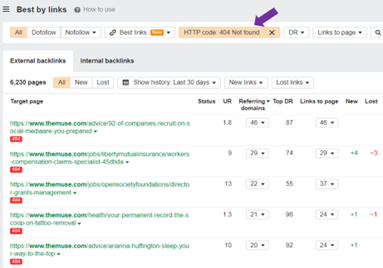
This research can identify the topics with the biggest potential to become the fixes for a broken link. You can create content to address them or identify content you already published. Just make sure the content closely matches the intent of the anchor text’s original link.
For example, the same research report, which is now a broken link, is cited in articles from Oyster and TINYpulse. On Oyster, the anchor text reads, “44% of companies did not allow remote work.” On TINYpulse, the anchor text says, “only 33% are very satisfied with the level of trust in their organization.”
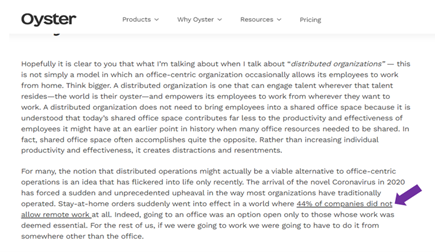
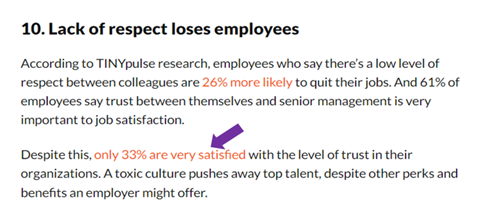
For a single article link to replace the broken link on Oyster and TINYpulse, the content would need to cite both a statistic about remote work and another stat about trust in organizations.
2. Guest posting
Like the broken-link replacement strategy, guest posting benefits both your and the recipient’s sites. You reach out to sites and offer to write content about a topic relevant to their audience that relates to your content subjects and includes a link to your site. This technique works well because you typically control where and how to add your link to make it as relevant as possible.
You can take multiple approaches to win guest-posting opportunities. No matter which tactics you use, track the sites and verify the site’s quality using Ahrefs, another tool, or a direct visit to the site.
First, you can use Ahrefs (or a similar tool) to examine your competitors’ backlinks and identify any links that come from guest posts. The anchor or surrounding text might hint at its status with phrases such as “contributed by,” “guest post by,” or the name of the brand or author. You also can check links manually to see if they’re contributed content.
In this example from Collegiate Parent, the headline reads “EFC Too High? Tips for Successful Aid Appeals” and includes a byline for “Billie Jo Weis.” At this point, you don’t know if it is a contributed article.

But scroll down to the end, and you can see the author’s bio. It confirms the article is a guest post because her bio says she is a client services advisor for My College Planning Team, not the publisher (Collegiate Parent).
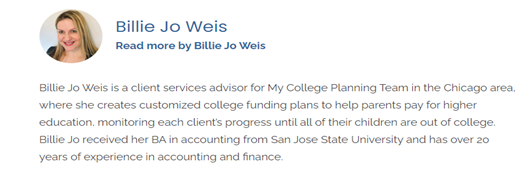
You can also use Google search operators to identify sites open to guest contributions. You’ll want to do several searches using variations of your target keywords and topic accompanied by phrases, such as “guest post,” “contributed by,” “guest post by,” and “guest posting guidelines.”
The example in the screenshot below works for a brand targeting college prep topics. The search is “’college prep’ ‘guest post by’ -site.pinterest.com.” The results reveal four articles from four sites that use the words “college prep” and “guest post by.” You can add those sites to your outreach tracker.

Finally, you can list sites relevant to your niche that didn’t appear in the earlier searches.
TIP: Not all sites that accept guest articles say so on their website.
3. Niche edits
A niche edit, sometimes referred to as a link insert, is a technique that adds a link to existing content. The key to success is finding relevant articles on high-quality sites and pitching your content as a valuable addition to those articles.
You can use a similar process to the Google guest post search. Input a broad keyword for your targeted keyword, then tell it you don’t want the targeted keyword in the title. If the entire article is about your targeted keyword, your chances of getting the publisher to include a link to a similar article are low.
Here’s an example from one of our client’s that sought to make niche edits for the keyword “soft skills.”
The Google search included these phrases:
- “Organizational development” soft skills -intitle:”soft skills”
- “Organizational development” soft skills employee training -intitle:”soft skills”
- Soft skills employee training -intitle:”soft skills” organizations
It led to an added link for “soft skills” in this article — “Employee Development,” which includes the header, “What are the benefits of employee development for an organization?”
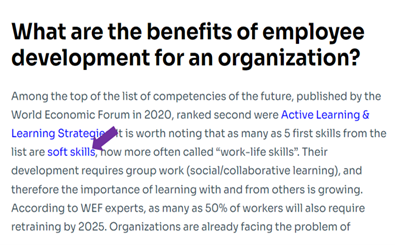
You can do several searches, modifying your search operators each time to see what sites and content appears. Think of multiple angles to broaden the potential sites that publish content with your targeted or a related keyword.
After you’ve crafted a list of high-quality prospects, it’s time for outreach.
Niche edits might be the hardest of the three strategies to achieve because they’re not as clear of a win-win situation as the other two (repairing broken links and publishing new content).
Your email pitch can make or break your niche-edit campaign. It must convince the publisher that your content provides so much value that they will want to take an extra step with content they’ve already completed.
Here are some tips to craft a link-earning email pitch:
- Start by mentioning something about them. It could be something you like about their website or the article you’re targeting. You want them to know you’ve explored their site and read the article. But don’t overdo it. A simple compliment or sentence about how you found the article helpful should suffice.
- Introduce your content and mention how it can help their audience. Be concise and convincing, but don’t oversell it.
- Go one step further and point to a section or sentence where you think your content might be a good fit. This will help them see where your content can add value and link to it.
Get linking
Though contextual link building may seem challenging to execute, it can bring great rewards. Follow these tips and strategies, and your valuable content will get more attention from external sites and eventually Google rankings where it deserves to be.
All tools mentioned in this article are identified by the author. If you have a tool to suggest, please tag CMI on social.
HANDPICKED RELATED CONTENT:
Cover image by Joseph Kalinowski/Content Marketing Institute
MARKETING
Google’s Surgical Strike on Reputation Abuse

These aren’t easy questions. On the one hand, many of these sites do clearly fit Google’s warning and were using their authority and reputation to rank content that is low-relevance to the main site and its visitors. With any punitive action, though, the problem is that the sites ranking below the penalized sites may not be of any higher quality. Is USA Today’s coupon section less useful than the dedicated coupon sites that will take its place from the perspective of searchers? Probably not, especially since the data comes from similar sources.
There is a legitimate question of trust here — searchers are more likely to trust this content if it’s attached to a major brand. If a site is hosting third-party content, such as a coupon marketplace, then they’re essentially lending their brand and credibility to content that they haven’t vetted. This could be seen as an abuse of trust.
In Google’s eyes, I suspect the problem is that this tactic has just spread too far, and they couldn’t continue to ignore it. Unfortunately for the sites that were hit, the penalties were severe and wiped out impacted content. Regardless of how we feel about the outcome, this was not an empty threat, and SEOs need to take Google’s new guidelines seriously.
-

 MARKETING3 days ago
MARKETING3 days ago18 Events and Conferences for Black Entrepreneurs in 2024
-

 WORDPRESS6 days ago
WORDPRESS6 days agoBest WordPress Plugins of All Time: Updated List for 2024
-

 MARKETING5 days ago
MARKETING5 days agoAdvertising on Hulu: Ad Formats, Examples & Tips
-

 MARKETING6 days ago
MARKETING6 days agoUpdates to data build service for better developer experiences
-

 WORDPRESS6 days ago
WORDPRESS6 days agoShopify Could Be Undervalued Based On A Long-Term Horizon
-

 PPC6 days ago
PPC6 days agoLow Risk, High Reward YouTube Ads alexking
-

 WORDPRESS4 days ago
WORDPRESS4 days ago5 Must See Telegram Plugins for WooCommerce
-

 MARKETING4 days ago
MARKETING4 days agoIAB Podcast Upfront highlights rebounding audiences and increased innovation













You must be logged in to post a comment Login